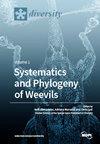标题韩国线虫科二种(线虫纲:线虫目)
IF 2.1
3区 生物学
Q2 BIODIVERSITY CONSERVATION
引用次数: 0
摘要
在韩国莞岛郡岩池地区的一次调查中,在海绵Hymeniacidon sinapium中发现了两个属于Cyatholaimidae科的物种,特此报告。尽管Cyatholaimidae家族具有单系性,但由于缺乏突触形态特征和重叠的一般诊断,它一直是线虫学家讨论的话题。许多定义属的特征由非唯一特征的组合组成,这些特征在分类学上可能不具有重要意义。因此,根据系统发育的发现,这个家族中的大多数属都是非单系的。分子数据的缺乏使鉴定分类学上重要的特征变得复杂,这些特征以前可能被忽视了。虽然孔隙复合体和侧孔样结构被认为是潜在的重要特征,但在大多数记录的物种中缺乏这些见解,也缺乏分子数据来证实它们在拓扑结构中的重要性。考虑到从基础开始需要大量的工作,本研究提供了在韩国发现的两个物种的形态学信息(包括分类描述、形态测量、将关键特征与所有有效同源物进行表格键比较、插图和显微镜照片)和分子数据(三个分子区域的部分序列、K2P距离比较和系统发育树)。该研究还为潜在的重要特征提供了见解,例如孔隙复合体和其他孔隙结构。三叉棘虫的韩国标本与原始的描述相似,如囊前补充物的数量和类型,以及针状体和管骨的形状。然而,观察到以下特征的变化:身体比例,神经环位置,咽长度以及存在或不存在oscelli。我们的部分分子序列也与NCBI上现有的一个单条目一致,该条目被鉴定为a (s) tridentatus。新种Paracanthonchus spongius sp. nov.与p.a kamui在身体和管膜的一般形状上最相似,但可以通过粪囊前补体的数量、两栖动物的位置和管膜比例的差异来区分。基于28S rRNA区域构建的系统发育树显示,这两个物种都属于高自举支持的单系进化分支。然而,要实现这些物种的属型分辨,未来还需要积累更多的同源分子序列。本文章由计算机程序翻译,如有差异,请以英文原文为准。
Two Species of the Family Cyatholaimidae (Nematoda: Chromadorida) from Korea
During a survey of the Wando-gun rockpool area in Korea, two species belonging to the family Cyatholaimidae were discovered within a sponge, Hymeniacidon sinapium, and are hereby reported. Despite the monophyletic nature of the family Cyatholaimidae, it has been a topic of discussion among nematologists due to its lack of synapomorphic characteristics and overlapping generic diagnoses. Many genus-defining features consist of a combination of non-unique characters, which may not hold significant taxonomic importance. Consequently, most genera within the family are non-monophyletic according to phylogenetic findings. The absence of molecular data complicates the identification of taxonomically important characteristics that may have been previously overlooked. While the pore complex and the lateral pore-like structure have been suggested as potentially important traits, these insights are lacking in most recorded species, along with molecular data to confirm their significance in topology. Given the considerable amount of work required from the ground up, this study provides both morphological information (including taxonomic description, morphometric measurements, tabular key comparing key features to all valid congeners, illustration, and microscope photographs) and molecular data (partial sequences of three molecular regions, K2P distance comparison, and phylogenetic trees) for the two species discovered in Korea. The study also offers insights on potentially significant traits, such as the pore complex and other pore structures. The Korean specimen of Acanthonchus (Seuratiella) tridentatus resembles the original description regarding aspects such as the number and type of precloacal supplements, as well as the shape of the spicules and gubernaculum. However, variations are observed in the following characteristics: body ratio, nerve ring location, pharynx length, and the presence or absence of the oscelli. Our partial molecular sequences of the specimens also match identically with a single existing entry on NCBI identified as A. (S.) tridentatus. The new species, Paracanthonchus spongius sp. nov., is most similar to P. kamui in terms of the general shape of the body and gubernaculum but can be distinguished by differences in the number of precloacal supplements, amphid position, and gubernaculum ratio. The phylogenetic tree constructed based on the 28S rRNA region shows both species grouped within the monophyletic clade of Cyatholaimidae with high bootstrap support. However, achieving generic resolution of these species will require more molecular sequences of congeners to accumulate in the future.
求助全文
通过发布文献求助,成功后即可免费获取论文全文。
去求助
来源期刊

Diversity-Basel
Environmental Science-Ecological Modeling
CiteScore
3.40
自引率
12.50%
发文量
925
审稿时长
11 weeks
期刊介绍:
Diversity (ISSN 1424-2818) is an international and interdisciplinary journal of science concerning diversity concept and application, diversity assessment and diversity preservation. It is focused on organismic and molecular diversity. It publishes reviews, regular research papers and short notes in the regular issues. Related news and announcements are also published. Our aim is to encourage scientists to publish their experimental and theoretical results in as much detail as possible. Therefore, there is no restriction on the length of the papers. Full experimental details must be provided so that the results can be reproduced.
 求助内容:
求助内容: 应助结果提醒方式:
应助结果提醒方式:


